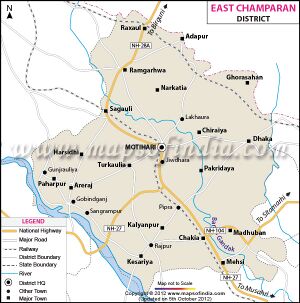Kesariya
| Author:Laxman Burdak, IFS (R) |

Kesariya (केसरिया) is a town in Bihar, in the district of East Champaran, near Rampur Khajuria (NH28). It was known as Isaliya (इसलिया) in ancient times and was an important Buddhist site.
Variants
- Isaliya (इसलिया) (जिला चंपारन, बिहार) (AS, p.84)
- Kesaria/Kesariya (केसरिया)(जिला मोतीहारी, बिहार) (AS, p.225)
Origin
History
It is the site of a stupa built by the King Ashoka. It is one of, if not the largest stupa in India. The Buddha once stayed in Kesariya (then called "Kesaputta").
Alexander Cunningham[1] writes that....According to Hwen Thsang the country of the Vrijis was long from east to west, and narrow from north to south.[2] This description corresponds exactly with the tract of country lying between the Gandak and Mahanadi rivers, which is 300 miles in length by 100 miles in breadth. Within these limits there are several ancient cities, some of which may possibly have been the capitals of the eight different clans of the Vrijis. Of these Vaisali, Kesariya, and Janakpur have already been noticed; the others are Navandgarh, Simrun, Darbanga, Puraniya, and Motihari. The last three are still inhabited and are well known ; but Simrun has been deserted for upwards of 550 years, while Navandgarh has probably been abandoned for at least fifteen centuries. Simrun has been described by Mr. Hodgson,[3] but its ruins still require to be carefully surveyed before we can form an opinion as to its probable antiquity. I visited Navandgarh my-self in 1862, and found it one of the oldest and most interesting places in northern India.
Jat History
Bhim Singh Dahiya[4] writes ....These is a village named Meena Majra, near Sonipat towards Ganaur, which contains ancient ruins, including the multi-story buildings. There are certain ancient temples and a large tank and goddesses near the site. The local People believe that this ancient city was capital of king Chakwa Ben. The identity of this ruler Chakwa Ben is not known to the historians. However a stupa near Kesariya, known by the name of Raja Ben Chakravarti is described by Hiuen-Tsang as a memorial of Chakravarti kings.[5] Carlleyle notes a similar local tradition from Bairat (Jaipur), and there too, the name is Chakwa Ben. [6] Cunningham mentions similar legends of Chakravarti Ben in Bihar, Awadh and Ruhel Khand. Carlleyle says, he was an Indo-Scythian king. He is right. The king belonged to Ben or Beniwal clan.
केसरिया
विजयेन्द्र कुमार माथुर[7] ने लेख किया है ...केसरिया (AS, p.225) (जिला मोतिहारी बिहार) मोतिहारी से 22 मील दूर है. इस ग्राम से एक मील दक्षिण, 62 फुट ऊंचा ढूह है, जिस पर ईंटों का 52 फुट ऊंचा स्तूप है जिसे ग्रामनिवासी 'राजा बेन का देवरा' कहते हैं. युवानच्वांग के वर्णन के अनुसार वैशाली वर्तमान बसाढ़, जिला मुजफ्फरपुर, बिहार, से 200 ली या 30 मील पर एक प्राचीन नगर था जिसके ये ध्वंसावसेश जान पड़ते हैं. यह स्तूप बौद्ध अनुश्रुति के अनुसार उस स्थान पर है जहां बुद्ध ने एक बड़े जनसमूह के सम्मुख घोषणा की थी कि पूर्व जन्म में भिक्षु बनने के लिए ही उन्होंने राज्य त्याग किया था. एक अवसर पर बुद्ध ने अपने प्रिय शिष्य आनंद से कहा था कि इस स्तूप को लोगों ने चक्रवर्ती राज्य के लिए ऐसे स्थान पर बनाया था जहां चार मुख्य मार्ग मिलते हैं. यह बात ध्यान देने योग्य है कि केसरिया के तीन चौथाई मील दूर दो मुख्य प्राचीन सड़कें मिलती है-- एक अशोक की राजकीय सड़क जो पाटलिपुत्र के दूसरी ओर गंगा के उत्तरी तट से नेपाल की घाटी तक और दूसरा छपरा से मोतिहारी होते हुए नेपाल जाती है. (दे.केसरिया)
इसलिया
विजयेन्द्र कुमार माथुर[8] ने लेख किया है ...इसलिया (AS, p.84) बिहार में स्थित है। इसलिया का वर्तमान नाम केसरिया है। प्राचीन बौद्ध स्तूप के खण्डहर आजकल राजा 'बेन का देवरा' नाम से प्रसिद्ध हैं फाह्यान ने इस स्थान को देखा था। बौद्ध किंवदन्ती के अनुसार इसलिया पूर्व जन्म में बुद्ध चक्रवर्ती राजा के रूप में जन्मे थे। इसी स्थान पर बुद्ध ने लिच्छवियों से विदा लेते समय अपना कमण्डल उन्हें दे दिया था। स्तूप इसी घटना का स्मारक था।
External links
References
- ↑ The Ancient Geography of India/Vajji, p.448]
- ↑ Julien's ' Hiouen Thsang,' ii. 403. See Map No. XI.
- ↑ See Map No. XI.
- ↑ Bhim Singh Dahiya: Jats the Ancient Rulers (A clan study)/Jat Clan in India, p.247-248
- ↑ V A Smith, Journal of Royal Asiatic Society, 1902, p. 271
- ↑ ASI, Vol. VI, p. 84
- ↑ Aitihasik Sthanavali by Vijayendra Kumar Mathur, p.225
- ↑ Aitihasik Sthanavali by Vijayendra Kumar Mathur, p.84

